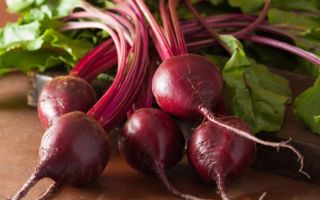Content
- 1 The chemical composition of beets
- 2 Nutritional value and calorie content of beets
- 3 What are the benefits of beets for the body?
- 4 At what age can beets be given to children
- 5 Slimming beets
- 6 Folk recipes with beets for the treatment of various diseases
- 7 Rules for the use of raw beets for various diseases
- 8 Raw beetroot masks for face and hair
- 9 What can be made from beets and what does it work with
- 10 Which is healthier: raw or boiled beets
- 11 Is it okay to eat raw beets every day
- 12 Why sore throat after eating raw beets
- 13 Beet tops: benefits and harms
- 14 How to store and choose beets correctly
- 15 Beetroot harm and contraindications
- 16 Conclusion
- 17 Reviews
The benefits and harms of beets have been appreciated in ancient times by both chefs and culinary specialists, and healers. The medicinal properties of beets were noted in ancient India - the first state to master the cultivation of this root vegetable from the Amaranth family. Later, many medicinal plants were discovered in this family, but none of them managed to surpass the potential of beets.

The chemical composition of beets
Immediately it is necessary to point out that there are several varieties of a vegetable that have a rather variegated vitamin and mineral composition, of which not all are used for food. Thus, sugar beet is an industrial crop and is rarely consumed even in animal feed. Therefore, you should immediately decide what types of beets we are talking about.
Currently, the following varieties of beets are consumed by humans:
- ordinary or dining room;
- chard;
- stern.
Mangold contains more sugars, and fodder contains more fiber. Otherwise, the chemical composition of these three varieties is almost the same. Let's consider it in more detail.
The beet contains the following vitamins:
- C - 10 mg;
- B5 - 0.12 mg;
- B6 - 0.07 mg;
- B9 - 0.13 μg;
- B1 - 20 μg;
- B2 - 40 mcg.
Microelements included in the vegetable:
- potassium - 288 mg;
- copper - 140 mg;
- phosphorus - 43 mg;
- calcium - 37 mg;
- magnesium - 22 mg;
- iron - 1.4 mg;
- iodine - 7 mcg.
In addition, beets contain 86 g of water, 2.5 g of dietary fiber and 0.1 g of organic acids. Betaine, or trimethylglycine, a substance involved in the synthesis of cell membranes, should be mentioned separately. It is one of the main hepatoprotectors, the concentration of which in beets is a record high - 129 mg per 100 g.
Nutritional value and calorie content of beets
The nutritional value of table beets is as follows:
- proteins - 14.3%;
- fats - 2.1%;
- carbohydrates - 83.6%.
The calorie content of the product depends on the variety and method of preparation of the vegetable. The table shows the average calorie value for various processing methods:
|
Cooking method |
Calorie content, kcal / 100 g |
|
Without processing |
43 |
|
Boiled / steamed |
44 |
|
Baked |
39 |
|
Stew |
106 |
What are the benefits of beets for the body?
The health benefits of raw beets are multifaceted and varied. This vegetable has two features that determine its widespread use:
- A unique vitamin, mineral and acid composition that is not found in any other vegetable.In terms of its effect on various systems of the body, none of the existing vegetables has such a wide spectrum.
- Approximately 90% of the components that make up a vegetable are not destroyed during heat treatment of the product. This means that in most cases it is possible to use both raw and boiled, stewed or pickled product with approximately the same therapeutic effect.
The latter feature is very important, since the taste of raw beets, to put it mildly, is not very good, and for many, its taste causes a negative reaction. Existing methods of its preparation are capable of changing the taste of a vegetable without significantly affecting its beneficial properties.
The health benefits of red beets are due to their chemical composition. One of the beneficial properties of a vegetable is its positive effect on intestinal peristalsis and regulation of metabolic processes throughout the body. The vegetable possesses such properties due to its organic acids and fiber. The latter makes the vegetable an indispensable product in the fight against constipation. The benefits of beets on an empty stomach will be especially relevant in the case of chronic forms of this disease.
The vegetable also contains the unique substance betaine, which is not contained in such an amount in any other product. The beneficial effects of this substance are as follows:
- regulation of fat metabolism;
- curbing obesity processes;
- liver protection;
- stabilization of blood pressure.
For the human body, the benefits of fresh beets also lie in regulating the work of the hematopoietic system. People who regularly use it never suffer from anemia.
The iodine contained in the vegetable has a beneficial effect on the functioning of the thyroid gland, strengthening the body's immune system. This is especially true for the elderly as well as those suffering from iodine deficiency.
The benefits of beet tops are primarily in the fact that with the same mineral composition as the root crop, it has a much lower calorie content (almost 3 times), and contains more than 40% of protein.
The heart health benefits of beets are due to the magnesium they contain. The vegetable is recommended for use in various heart and cardiovascular diseases: hypertension, ischemia, atherosclerosis.
The benefits of beets in old age are manifested primarily as the normalization of cholesterol metabolism. In addition, it helps in the processes of blood formation. The benefits of the vegetable in the prevention of diseases of the nervous system in the elderly have been noticed.
The benefits of beet cake also play an important role. Due to the record concentration of fiber (in fact, the cake is almost 100% fiber), it is the most effective way to cleanse the intestines.
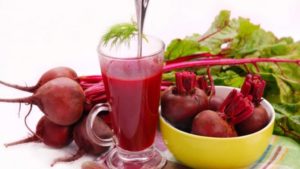
Benefits of beets for women's health
The benefits of beets for a woman's body lie primarily in their ability to maintain the hematopoietic system of the body in a healthy state. Women often have problems with the normal functioning of this system due to menstruation, as well as anemia.
An important role for women is played by beets with cystitis. Due to the peculiarities of the genitourinary system in women, this disease is especially difficult. With it, it is recommended to eat beets in large quantities, since the vegetable is not only a diuretic, but also promotes faster healing of the bladder mucosa.
Useful properties of beets for men
For men, beets will be useful as a hematopoietic agent, as well as a means to strengthen muscles and maintain libido. Root vegetables or their juice are often used as an adjuvant therapy for erectile dysfunction.
Taking into account the peculiarities of the digestive system of men, they note the considerable benefits of raw beets for the liver. It is not only a hepatoprotective agent thanks to the betaine it contains, but also helps to cope with another problem - cholecystitis.This disease occurs in men much more often than in women. Therefore, the use of beet products for the gallbladder is especially important for them.

Benefits of beets for pregnancy and breastfeeding
Pregnancy and breastfeeding in most cases are associated with one unpleasant problem - anemia. Its causes can be very different, but the result is always negative: low hemoglobin levels create problems in the supply of oxygen to the mother's body. This negatively affects primarily the performance of the brain.
Often during pregnancy and lactation, due to hormonal imbalance in women, taste is significantly distorted, which, of course, affects food preferences. Some foods can simply be dropped from the diet for psychosomatic reasons. And often the list of such products includes raw or boiled beets that a woman needs so much. Therefore, it is recommended to use it stewed. The benefits of stewed beets are almost the same as those of raw beets, while the vegetable has a much more "acceptable" taste and is eaten by pregnant and lactating women more willingly.
At what age can beets be given to children
Given the high allergenicity of the vegetable, it is one of the last to be introduced into plant foods. The minimum age at which the digestive system is able to digest it is 7-8 months. At this age, children are given it in the form of puree.
Before this, the beets should be boiled thoroughly, at least for an hour and a half, and then grated. Kids don't really like the taste of beets, so it is recommended to give them to children in a mixture with boiled cabbage and potatoes (in equal proportions).
Complementary feeding should be started with half a teaspoon. In case of allergic reactions, stop immediately. However, beets must be introduced into the diet, so after a month you must try to give complementary foods again.
Starting from a year, when children have a sufficient number of teeth, it is allowed to give beets in the form of vinaigrette or in the form of cubes seasoned with sour cream with added sugar.

Slimming beets
Due to its low calorie content, cleansing properties and the complex of vitamins and microelements contained in the vegetable, it can be used in various weight loss regimens and diets. Losing weight with beets is usually done in a mono-diet format or in the form of a combination of vegetables with other foods, such as kefir. Also, a combination of vegetables with protein foods (lean meat or steamed fish) is often used.
Mono diets usually last no more than three days, while you must adhere to the following simple rules:
- the use of salt is prohibited;
- at least 2 liters of water should be taken during each day of the diet.
During the day, the amount of product consumed should be about 1 kg. At the same time, beets are used in almost any form: both raw and baked, boiled, and so on. You can cut it into small cubes and add a little olive oil. Due to the properties of beets, weight loss with such a diet will be about 2 kg. It is recommended to repeat such a mono-diet no more than once every 3-4 weeks.
Beetroot diet with kefir is recommended for use once a month. At the same time, it consists of the following stages: introductory, which takes 2-3 days, a weekly pause and the main course, lasting 7 days. During the diet days, meals are made according to the following scheme:
- the waking time is divided into 8 approximately equal intervals;
- at the beginning of each interval, a meal is carried out, consisting of 200 ml of kefir and medium-sized boiled beets;
- kefir is taken first, and after about an hour, beets are consumed.
You should take no more than 1.5 liters of kefir and no more than 1.5 kg of vegetables per day. This diet allows you to lose up to 7 kg of weight.
The lean meat diet lasts 10 days. The basis of the diet will be meat and beets, however, it is allowed to use low-calorie dishes: vegetable salads, fruits, tea without sugar, and so on.
The basic rule of this diet is the following: a glass of beet juice should be consumed before each meal. The use of various sweet dishes, flour and confectionery products, carbonated drinks and other things like that should be excluded.
There are three main meals with such a diet. For breakfast, a vegetable is usually served in any form with low-fat cottage cheese and tea without sugar. Lunch and dinner can be supplemented with cereals and vegetable stews without animal oil, salt and sugar. You can use various herbs or lemon juice as a seasoning.
It is allowed to cook dishes containing beet leaves, since they are rich in protein and contain fewer carbohydrates than root vegetables.
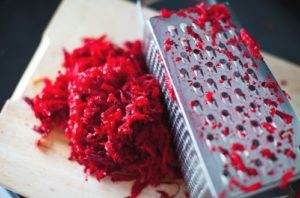
Folk recipes with beets for the treatment of various diseases
In folk recipes, raw beets are used relatively rarely. Most often, the vegetable is combined with other traditional medicines (for example, apples, honey, raisins).
For the treatment of a number of diseases, more exotic products are also used: pickled beets baked with prunes and nuts, kvass from it, and so on.
Hypertension
The benefits of beets for hypertension lie in the ability of the beetroot to stabilize blood pressure levels. In this case, beet kvass or beet-carrot juice is used.
Kvass is prepared as follows:
- You need to take 1 kg of vegetables, 1.5 liters of water and 1 tbsp. a spoonful of sugar.
- The vegetable is peeled, cut into slices and placed in a three-liter bottle.
- Water is brought to a boil and poured there. Then sugar is added.
- The bottle is closed with gauze and placed in a warm and dark place. After 4 days, the kvass is ready.
- It is filtered, some more sugar is added for flavor and placed in the refrigerator.
- It is taken three times a day before meals, 200 ml. Repeat in a month.
The juice is made as follows: 1 liter of juice is obtained from both vegetables, after which they are mixed and placed in the refrigerator. Apply 2-3 times a day on an empty stomach half an hour before meals, 100-150 ml. Mandatory reception half an hour before bedtime.
Raw beets for psoriasis
The benefits of beetroot for psoriasis have long been disputed by traditional medicine, but folk remedies recommend dishes made from it for additional therapeutic effects.
The recipe for using a vegetable for psoriasis is as follows:
- a root vegetable weighing 100-200 g is cleaned and cut into strips of 5 x 5 mm;
- a little salt and adjika are added to the straw;
- 1 tbsp is added to the dish. spoon of vegetable oil.
It is consumed as a salad at lunch for a month. This is followed by a two-week break, and the procedure is repeated.
Beets with garlic for constipation
The main use of beets for intestines is to cleanse the intestines, which can be a by-product of constipation relief. The vegetable itself has a significant diuretic and laxative effect, but there are foods, for example, garlic, that can significantly enhance this effect.
The recipe itself is quite simple: 200 g of beets and 1 clove of garlic are crushed and 1 tbsp is added to them. a spoonful of vegetable oil or mayonnaise. Salt is added to taste. It is best consumed during lunch.
Another, no less effective (and even more useful) remedy for constipation is “Panicle” salad, which also includes carrots. The benefits of fresh beetroot and carrot salad have long been proven in practice. It is not only a laxative, but also cleanses the liver and bile ducts.
The recipe for the salad is as follows: you need to rub 200-300 g of beets and carrots on a coarse grater, squeeze 1-2 cloves of garlic into them, mix thoroughly and pour the resulting mass of 1-2 tbsp. tablespoons of vegetable or olive oil.
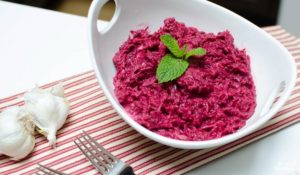
Rules for the use of raw beets for various diseases
Beetroot is a vegetable rich in active substances, therefore its use has a number of limitations associated, in particular, with the course of certain chronic diseases. So that the benefits of the vegetable do not turn into harm, you should remember in which cases you should limit its use.
With gastritis
Eating raw vegetables is not recommended, as this leads to ulcers and a significant deterioration in the patient's health. The use of pickled vegetables also negatively affects the gastric mucosa. It is recommended to use the root vegetable exclusively in boiled form.
With pancreatitis
In acute pancreatitis, the use of rough food is excluded, so beets rich in fiber should not be present in the diet of such patients.
If pancreatitis has passed into a state of stable remission, it is allowed to use dishes from boiled beets, but not more than 100 g per day. In this case, you need to start with small doses (from 10-15 g per knock), gradually bringing them to a full dose of 100 g.
With gout
The use of a vegetable is recommended for gout, both with its exacerbation and with remission. It is not recommended to eat a vegetable every day, but once every 2-3 days a vegetarian borscht or beet salad with the use of any not prohibited ingredients is desirable.
Beet kvass also has a good effect on the condition of patients with gout.
With diabetes mellitus
Beets are good for diabetics' health in acceptable doses. In type 2 diabetes, it can be used no more than 50 g raw or as juice. You can eat a little more boiled vegetable - from 100 to 200 g per day.
Raw beetroot masks for face and hair
The beneficial properties of beets are used in cosmetics. The most widespread are various vegetable masks.
A nourishing face mask can be made as follows: take a teaspoon of grated root vegetables, a teaspoon of sour cream and egg yolk. A layer of grated vegetable is applied to a cotton cloth with holes for the nose and eyes, on top of which is a mixture of sour cream and yolk. The fabric is gently applied to the face and kept on it for half an hour, after which the mask is washed off with water.

Hair mask helps fight dandruff and strengthens hair. For its preparation, take 50 g of beets, onions and burdock oil. Vegetables are rubbed on a fine grater and mixed with heated oil. Then the mixture is applied to the hair and kept on it for 30-40 minutes. At the end of the procedure, the hair is washed with a regular shampoo.
The frequency of using such a mask is 1 time in 10 days.
What can be made from beets and what does it work with
Many dishes are made from beets. First of all, these are vegetable dishes - salads and various mixes. Beets in all types of cooking are used in various side dishes and first courses. There are many soups that include beets. Separately, it should be noted such exclusively "beet" dishes as borscht, beetroot and botvinia.
The vegetable finds its use in various types of vegetable caviar and even casseroles. Many different drinks are made from it.
Beets can be combined with a wide variety of foods. These include:
- all vegetables;
- lean meat;
- fish;
- legumes;
- greens;
- nuts;
- dried fruits.
But beets are incompatible with pure milk. But with fermented milk products, it is strongly recommended to use it. The benefits of beets with sour cream or kefir have long been proven by nutritionists and doctors.
Which is healthier: raw or boiled beets
Since the composition of the root crop practically does not change during heat treatment, we can say that there is practically no difference between them. However, in boiled form, the product has several features that make its use "softer" and slightly expanding the scope. Boiled beets are less active chemically and less irritating to mucous membranes.
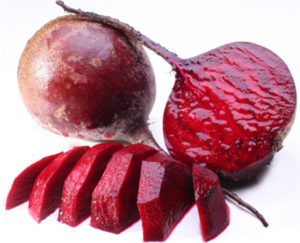
Due to the binding of sugars when cooking a vegetable, its glycemic index becomes approximately two times higher (from 30 it rises to 65), however, given that the total number of carbohydrates in the product is small, this does not affect its use for diabetics. The glycemic load per unit of mass in beets remains one of the lowest, and the main limitation of the daily dose for this category of people is in completely different properties of beets - the effect of fiber on the gastrointestinal tract and acid composition on metabolism.
Is it okay to eat raw beets every day
As such, there is no ban on the daily use of a raw product, but one should not forget that regular cleansing of the body, which occurs during its use, is not useful.
Ultimately, everything is determined by the daily dose of the product. If you eat 100-150 g of a vegetable every day, then it will not harm the body. "Shock" doses of beets, used, for example, during periodic cleansing of the body or diets, of course, should be daily for a limited time (from 3 to 7 days), after which long pauses are recommended in the use of this product - from 1-2 weeks to 3 months.
Why sore throat after eating raw beets
Often the cause of discomfort in the throat when eating beets is either a high concentration of acids, or its high sensitivity due to illness or microtraumas. Do not forget that the juice of a raw vegetable is irritating to the mucous membranes.
There is nothing bad or unnatural in this, and over time, such feelings pass. However, if this does not happen, you should seek the advice of a specialist.
Beet tops: benefits and harms
Beet tops retains most of the useful properties of a root crop, however, it has a number of features:
- high protein content;
- reduced carbohydrate content;
- more, in comparison with root crops, the content of some vitamins (for example, P and U);
- more acidity.
We can say that the tops of a vegetable is a more dietary product, and is more suitable for losing weight and cooking low-calorie meals.
At the same time, the vegetable tops contain a relatively large amount of oxalic acid. This chemically active substance forms water-insoluble compounds with calcium and phosphorus, which are very poorly eliminated from the body and are one of the main causes of kidney and gallbladder stones. Therefore, it is better not to use the tops of the product for patients suffering from similar diseases.
Also, vegetable tops can harm people taking anticoagulants, because they contain a lot of vitamin K.
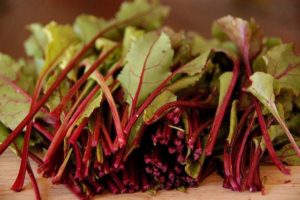
How to store and choose beets correctly
The choice of beets is made both by external and internal characteristics - it is advisable to cut the root crops before buying in order to assess the quality of the pulp and its structure. The roots themselves must be firm and resilient.If they are soft, this may indicate a violation of storage conditions or even the fact of freezing of the vegetable.
The smell of the root crop should be characteristic of beetroot, without signs of decay. There should be no black ulcers or a large number of small dots on the root crops and inside them. There should also be no voids in the vegetable.
The cut of the root crop should be juicy, with a rich red or red-purple color. However, excessively pronounced colors may indicate an uncontrolled use of fertilizers. It is advisable to additionally test such vegetables for the presence of nitrates in them.
Root crops are stored in a refrigerator or in a basement with a temperature from 0 to +2 ° C. Exceeding the temperature above +4 ° C leads to the germination of the vegetable. In the refrigerator, beets are stored in a plastic bag, in the basement - in boxes with good air ventilation to prevent rot.
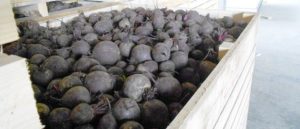
Beetroot harm and contraindications
In case of non-observance of contraindications, beets can harm the body. Contraindications for a vegetable include:
- low blood pressure;
- increased acidity of the stomach;
- urolithiasis and cholelithiasis;
- osteoporosis;
- chronic diarrhea;
- type 1 diabetes mellitus;
- allergies and individual intolerance.

Conclusion
Despite the fact that the benefits and harms of beets have long been studied, the issues of its competent use are still relevant. This is one of the most useful vegetables for the human body, but it should not be considered a panacea and consumed uncontrollably or in violation of certain prohibitions and contraindications.

